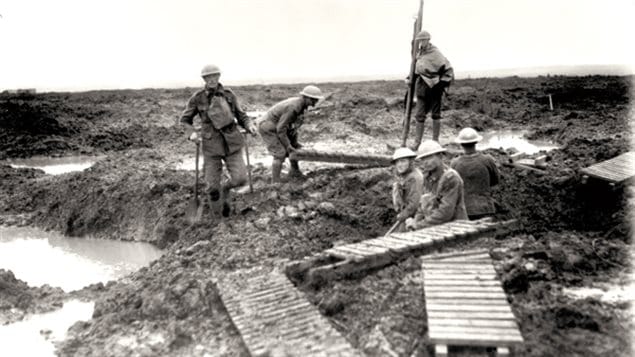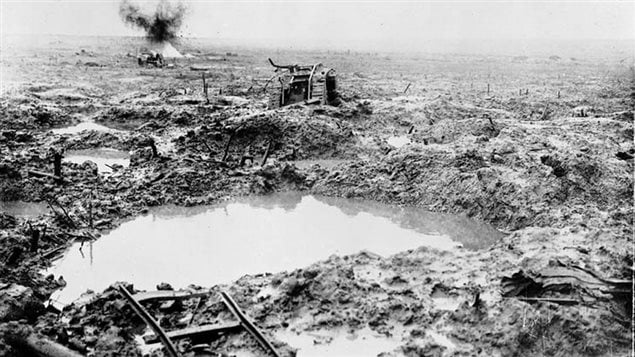It’s called the Third Battle of Ypres, but is more commonly known simply as Passchendaele, after the nearby village and slight ridge.
To relieve pressure on the French forces, Field Marshall Sir Douglas Haig commanding British forces, planned to attack Germans in Ypres. The purpose was to push the Germans back and prevent their further access to U-boat bases on the coast which were causing huge losses at sea.
Many criticized Haig’s plan to attack across the low flat plains of Flanders. They had become a sea of heavy mud with the incessant artillery fire having destroyed dikes and drainage ditches which normally kept the ground dry. Early and heavy rains only made the situation worse as fields became impossible with craters of fetid water often filled with the bodies of the fallen.

The British and ANZAC attack was launched on July 31, the day the rains began, but immediately resulted in massive losses as German machine guns swept the plain. Months went by with only a few kilometers gained and the Germans still controlling Passchendaele ridge.
After losses of over 250,000 the Canadians were called in.
After massive losses of dead, wounded and maimied, the surviving British, Australian and New Zealand troops (ANZAC) were exhausted. Haig then called in the Canadians. Canadian General Arthur Currie in surveying the scene was shocked at Haig’s plan and the tactical conditions and he objected vehemently, realizing the virtual impossibility of the field.
Haig, who had already failed to capitalize on the capture of the Messines Ridge in June, nonetheless insisted, He once again falsely believed that German morale was near collapse. It was the same misjudgement he had made during the horrific Somme campaign. Now desperate for any kind of victory, he overruled the Canadian General and ordered the Canadians to take over the line and the attack.
As he had done with the Canadian success at Vimy Currie planned and organized first. When the four Canadian divisions arrived in Flanders in mid-October, Currie began to carefully prepare in spite of the lack of time.
This meant building new supply roads, creating new or improved gun pits, repairing and extending the light rail tramways, and training. This was all still within reach of German guns and many would be killed or wounded before the battle was even begun.
Currie planned four phases, but still had estimated the battle would cost 16, 000 Canadian casualties.
Currie had also set attainable goals in several steps. On October 26 the first attack was launched, and by the end of the second attack, the Canadians had reached the outskirts of Passchendaele on October 30.
On November 6, the Canadians finally took the shattered village in the face of whithering resistance and counter-attacks. By the 10th, they had pushed the Germans off the nearby ridge, succeeding in mere weeks, where the British and ANZACS had failed during a horrific campaign of several months.
Nine Canadians earned the Victoria Cross (the highest award for military valour a Canadian can earn) in the battle: Private Tommy Holmes, Captain Christopher O’Kelly, Sergeant George Mullin, Private James Peter Robertson, Corporal Colin Barron, Private Cecil Kinross, Lieutenant Hugh McKenzie and Lieutenant Robert Shankland. Two of these men, MacKenzie and Robertson, did not survive the battle to receive their medals.
The efforts of all these men were beyond remarkable, but certainly the success was due in no small part to another VC winner. Major Pearkes of the 5th Canadian Mounted Rifles. Despite a leg wound, he led a few dozen of his men through heavy enemy fire across open ground to capture a strategically located farm. They then fought off numerous counter-attacks for more than a day, preventing the Germans from destroying the main advancing Canadian force from the side.
In the end, Currie’s estimate of 16,000 casualties proved tragically accurate, with 4,000 dead, and almost 12,000 wounded.
The British losses however were estimated at over 275,000, along with over 36,000 Australians and almost 4,000 New Zealands, all of which only added to Haig’s reputation as a butcher.
However, it also added to the Canadian’s already growing reputation among the Germans as a feared force, and it was soon learned that the presence of Canadians in the field had to be hidden as the Germans would rush bring in reinforcements if they learned they would face Canadian troops.
…At last we were under enemy gunfire and I knew now that we had not much further to carry all this weight. We were soaked through with rain and perspiration from the efforts we had been making to get through the clinging mud, so that when we stopped we huddled down in the nearest shell hole and covered ourselves with a groundsheet, hoping for some sort of comfort out of the rain, and partly believed the sheet would also protect us from the rain of shells. I shivered alongside Stephens who was a quiet, kindly and refined lad having his first taste of the front line. Together we huddled in this hole when there was a great thump behind us, but mercifully that shell failed to explode. As the shelling grew worse it was decided we had better move on, so reloading ourselves we pushed through the mud again and amid the din of the bursting shells I called to Stephens, but got no response and just assumed he hadn’t heard me. He was never seen or heard from again. He had not deserted. He had not been captured. One of those shells that fell behind me had burst and Stephens was no more.
– Private John Pritchard Sudbury
Wounded at Passchendaele
26 October 1917.1







For reasons beyond our control, and for an undetermined period of time, our comment section is now closed. However, our social networks remain open to your contributions.